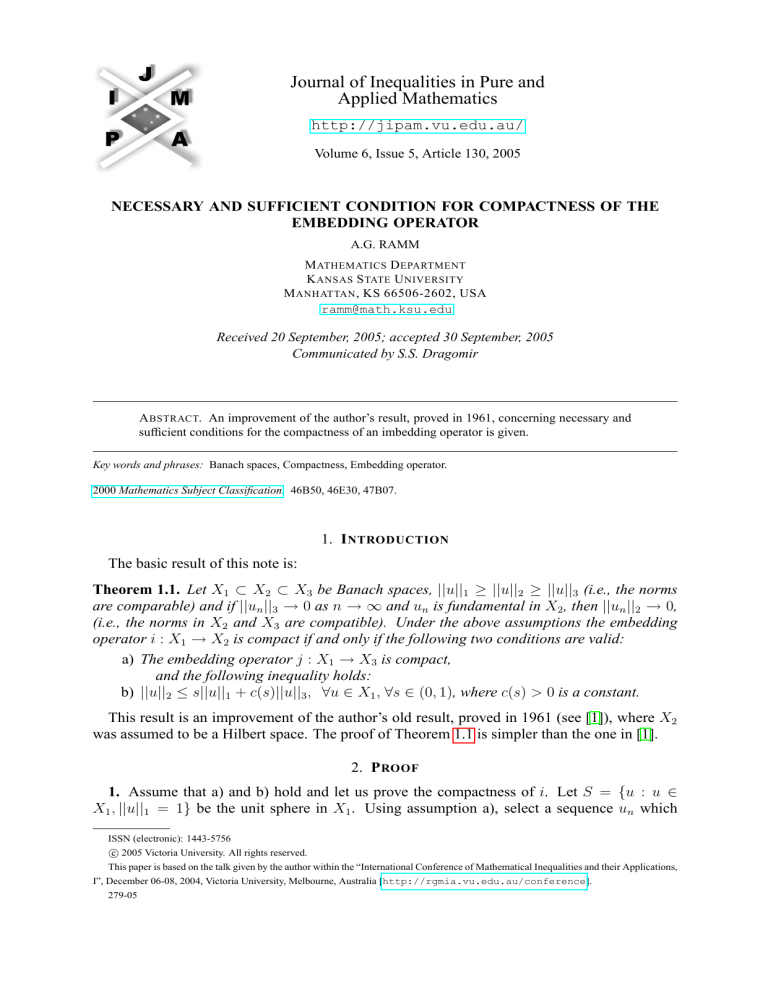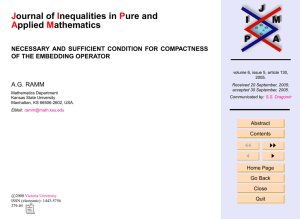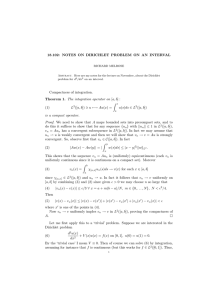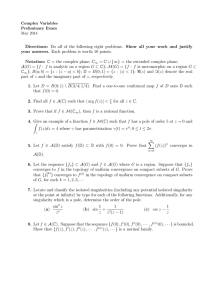
Journal of Inequalities in Pure and
Applied Mathematics
http://jipam.vu.edu.au/
Volume 6, Issue 5, Article 130, 2005
NECESSARY AND SUFFICIENT CONDITION FOR COMPACTNESS OF THE
EMBEDDING OPERATOR
A.G. RAMM
M ATHEMATICS D EPARTMENT
K ANSAS S TATE U NIVERSITY
M ANHATTAN , KS 66506-2602, USA
ramm@math.ksu.edu
Received 20 September, 2005; accepted 30 September, 2005
Communicated by S.S. Dragomir
A BSTRACT. An improvement of the author’s result, proved in 1961, concerning necessary and
sufficient conditions for the compactness of an imbedding operator is given.
Key words and phrases: Banach spaces, Compactness, Embedding operator.
2000 Mathematics Subject Classification. 46B50, 46E30, 47B07.
1. I NTRODUCTION
The basic result of this note is:
Theorem 1.1. Let X1 ⊂ X2 ⊂ X3 be Banach spaces, ||u||1 ≥ ||u||2 ≥ ||u||3 (i.e., the norms
are comparable) and if ||un ||3 → 0 as n → ∞ and un is fundamental in X2 , then ||un ||2 → 0,
(i.e., the norms in X2 and X3 are compatible). Under the above assumptions the embedding
operator i : X1 → X2 is compact if and only if the following two conditions are valid:
a) The embedding operator j : X1 → X3 is compact,
and the following inequality holds:
b) ||u||2 ≤ s||u||1 + c(s)||u||3 , ∀u ∈ X1 , ∀s ∈ (0, 1), where c(s) > 0 is a constant.
This result is an improvement of the author’s old result, proved in 1961 (see [1]), where X2
was assumed to be a Hilbert space. The proof of Theorem 1.1 is simpler than the one in [1].
2. P ROOF
1. Assume that a) and b) hold and let us prove the compactness of i. Let S = {u : u ∈
X1 , ||u||1 = 1} be the unit sphere in X1 . Using assumption a), select a sequence un which
ISSN (electronic): 1443-5756
c 2005 Victoria University. All rights reserved.
This paper is based on the talk given by the author within the “International Conference of Mathematical Inequalities and their Applications,
I”, December 06-08, 2004, Victoria University, Melbourne, Australia [http://rgmia.vu.edu.au/conference].
279-05
2
A.G. R AMM
converges in X3 . We claim that this sequence converges also in X2 . Indeed, since ||un ||1 = 1,
one uses assumption b) to get
||un − um ||2 ≤ s||un − um ||1 + c(s)||un − um ||3 ≤ 2s + c(s)||un − um ||3 .
Let η > 0 be an arbitrary small given number. Choose s > 0 such that 2s < 12 η, and for a fixed
s choose n and m so large that c(s)||un − um ||3 < 21 η. This is possible because the sequence un
converges in X3 . Consequently, ||un − um ||2 ≤ η if n and m are sufficiently large. This means
that the sequence un converges in X2 . Thus, the embedding i : X1 → X2 is compact. In the
above argument the compatibility of the norms was not used.
2. Assume now that i is compact. Let us prove that assumptions a) and b) hold. Assumption
a) holds because ||u||2 ≥ ||u||3 . Suppose that assumption b) fails. Then there is a sequence un
and a number s0 > 0 such that ||un ||1 = 1 and
(2.1)
||un ||2 ≥ s0 + n||un ||3 .
If the embedding operator i is compact and ||un ||1 = 1, then one may assume that the sequence
un converges in X2 . Its limit cannot be equal to zero, because, by (2.1), ||un ||2 ≥ s0 > 0. The
sequence un converges in X3 because ||un −um ||2 ≥ ||un −um ||3 , and its limit in X3 is not zero,
because the norms in X3 and in X2 are compatible. Thus, (2.1) implies ||un ||3 = O n1 → 0 as
n → ∞, while limn→∞ ||un ||3 > 0. This is a contradiction, which proves that b) holds.
Theorem 1.1 is proved.
R EFERENCES
[1] A.G. RAMM, A necessary and sufficient condition for compactness of embedding, Vestnik of
Leningrad. Univ., Ser. Math., Mech., Astron., 1 (1963), 150–151.
J. Inequal. Pure and Appl. Math., 6(5) Art. 130, 2005
http://jipam.vu.edu.au/




